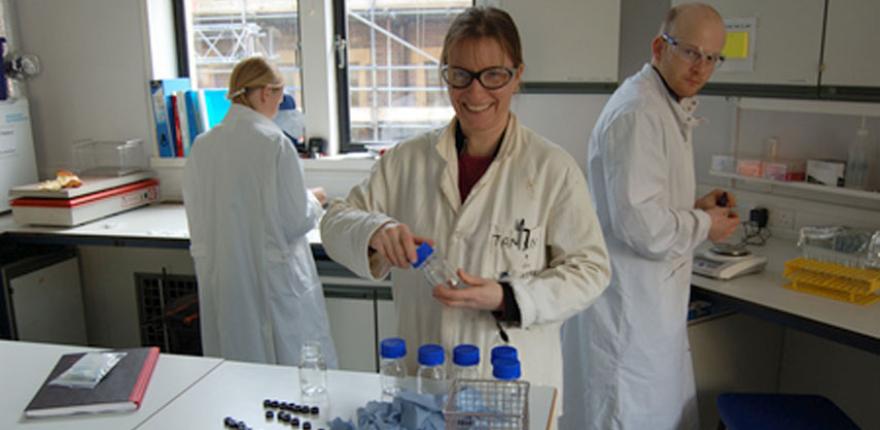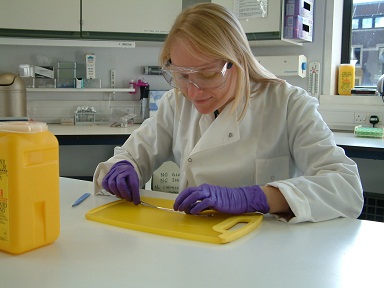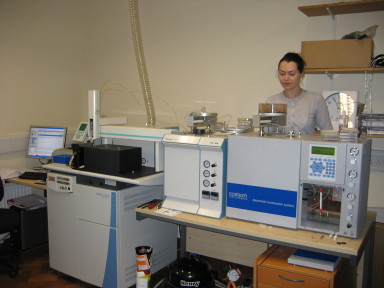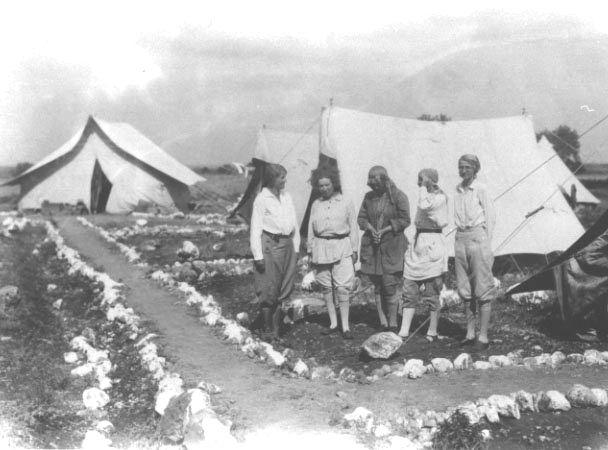Dorothy Garrod Laboratory
Department of Archaeology
Courtyard Building
Downing Street
Cambridge CB2 3ER
Director Dr Tamsin O'Connell
Technician Catherine Kneale
Department of Archaeology

Here in the Dorothy Garrod Lab we focus on the use of isotope analysis to investigate our human ancestors and their interaction with plants, animals and landscapes. We address questions about diet and nutrition, palaeoclimate and palaeoenvironment, ecology, mobility and origins. Our work uses the following isotopic measurements: δ13C, δ15N, δ18O, δ34S, δD, 87/86Sr. We analyse a wide variety of samples including bone, teeth, hair and whiskers, skin, plants and shells. Samples analysis by the Dorothy Garrod Lab has provided new insight on material culture changes across the Anglo-Saxon period, the resilience and sustainability the Indus Civilisation and diet and mobility in 14th Century Cambridge, to give just a few examples.
Laboratory Members include undergraduate, masters and doctoral students, post-doctoral researchers and academic staff.
We welcome applications to join the laboratory from potential post-docs, visiting fellows and students, PhD and MPhil students. We welcome academic collaborations with other individuals and external institutions, and undertake semi-commercial work on a project-by-project basis. For more information or to discuss this further please contact the Lab.
We have the facilities in-house to prepare a wide variety of samples for isotopic analysis. We analyse human, plant and animal samples, both archaeological and modern. For analysis guidance please see Laboratory Documentation for download at the bottom of this page.

Freeze-driers, centrifuges, drilling equipment, extraction hoods, oven, hot block. Strontium sample preparation is carried out in the clean room facilities in the Department of Earth Sciences.

All isotopic analyses are carried out via collaboration with the Godwin Laboratory, Department of Earth Sciences. We routinely analyse isotopes of carbon, nitrogen, oxygen and strontium, and can also measure hydrogen and sulphur.
Mass spectrometers:
Required Sample Sizes
|
Material |
Sample size |
|
Bone, antler and tooth collagen |
0.5-1.0g of dry bone |
|
Tooth enamel (carbonate) |
7-10mg of powdered enamel |
|
Tooth enamel (phosphate) |
1mg of powdered enamel |
|
Hair keratin |
0.5-1.0cm of hair |
|
Shell carbonate |
0.1mg |
|
Plants |
1-10mg |
Potential applicants must get in contact with us to discuss suitable projects prior to the submission of any application.
We welcome academic visitors to the group for periods of up to a year. The McDonald Institute charges visitors to the laboratory a small termly bench fee to cover the use of its facilities. Visitors are responsible for securing their own funding before applying to join the Dorothy Garrod Lab.
Visiting students staying longer than 6 months may be required to pay university fees. Please contact the Department’s Graduate Adminstrator for details.
MPhil/PhD students
Students wishing to join the Lab for a PhD or MPhil can apply to various sources of funds:
Do pay attention to funding deadlines, as these may be considerably earlier than deadlines for your application to study. Students can apply for funding before securing an offer of study and indeed most students apply for admission and apply for funding concurrently. Extensive further information can be found in the graduate prospectus.
Potential research students should note that laboratory-based projects involving isotopic analyses generally require research funds of several thousands of pounds, in addition to fees and maintenance. This should be discussed with the Lab Director.
Post-Doctoral Positions
When funded post-doc positions are available, they are usually linked to specific projects and are advertised on the department web page. Post docs wishing to join the group can apply for independent funding though one of the following routes:
This is not an exhaustive list and if you are interested in such a position, you should investigate other possible sources of funding.
The Laboratory is named after Dorothy Annie Elizabeth Garrod, CBE, FBA (5 May 1892 – 18 December 1968), an English archaeologist who specialised in the Palaeolithic period. She held the position of Disney Professor of Archaeology at the University of Cambridge from 1939 to 1952, and was the first woman to hold a Chair at either Cambridge or Oxford.
Contributions to Archaeology
In 1913, Garrod entered Newnham College, Cambridge where she was one of very few women students at the university. She graduated in 1916 with a degree in history. After demobilisationf orn war work during WW I she read for a Diploma in Anthropology at the Pitt Rivers Museum, University of Oxford, where she enrolled in 1921. She was taught by Robert Ranulph Marett and received a distinction on graduating in 1922. She then studied for two years with the French prehistorian Abbé Breuilat the Institut de Paleontologie Humaine in Paris. Garrod subsequently became renowned for her excavations in Gibraltar, Bulgaria and across the Middle East in what were then Palestine and southern Kurdistan.
Awards and Honours
Following the publication of her excavations The Stone Age of Mount Carmel (1937), Garrod was awarded Honorary Doctorates from the University of Pennsylvania and Boston College and a DSc. from Oxford University. She was elected a Fellow of the British Academy in 1952, and in 1965 she was awarded the CBE. In 1968 the Society of Antiquaries of London presented her with its Gold Medal. In 2017, Newnham College a new college building after Garrod.
For a fuller account of Dorothy Garrod's connection with Cambridge see the biographical essay by P. J. Smith.
 Dorothy Garrod with the members of her first excavation crew at the Mount Carmel Caves, 1929. Standing in their camp are left to right, Elinor Ewbank (Lady Margaret Hall, Oxford), Dorothy Garrod, Mary Kitson Clark (Girton College, Cambridge), Dean Harriet M. Allyn (Mount Holyoke College, USA) and Dr Martha Hackett. Photograph by courtesy of the Fonds Suzanne Cassou de Saint-Mathurin, MAN.
Dorothy Garrod with the members of her first excavation crew at the Mount Carmel Caves, 1929. Standing in their camp are left to right, Elinor Ewbank (Lady Margaret Hall, Oxford), Dorothy Garrod, Mary Kitson Clark (Girton College, Cambridge), Dean Harriet M. Allyn (Mount Holyoke College, USA) and Dr Martha Hackett. Photograph by courtesy of the Fonds Suzanne Cassou de Saint-Mathurin, MAN.